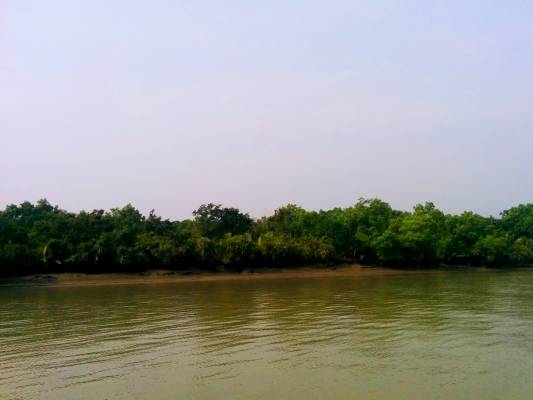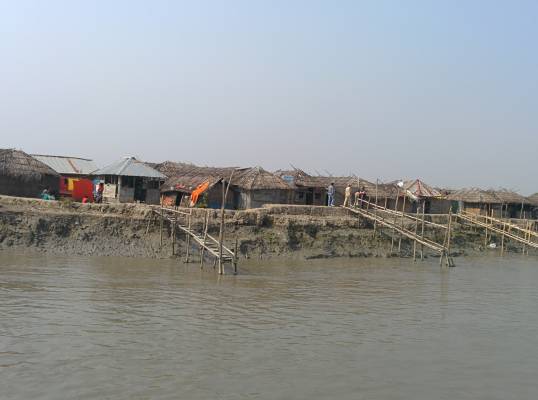Imagine a pristine forest where the the royal Bengal tiger hunts openly, where Irrawaddy dolphins and Ganges river dolphins swim freely, where green frogs hop around and Indian Skimmer chirps melodiously. Now add to your image the smoke from chimneys of a 1320 MW coal power plant, add the mercury from hundreds of thousands tons of fly ash leaching into the stream, and the oil and coal spills from 400 boats crossing each day the river where dolphins swim; now cut down the forest where frogs hop and birds sing…. This, my friend, is soon to be the reality of Sundarbans, the largest remaining mangrove forest on planet Earth:

This Ramsar and World Heritage site holds nearly 400,000 ha of mangrove forest that encompass the largest habitat of the Bengal tiger, being also the only mangrove forest where tigers are found. The fauna and flora composition of the Sundarbans is very rich and diverse. Sundarbans is home to 693 species of wildlife, including 210 fish and 315 bird species.
Any threat to mangroves pose threat to millions of lives dependent on it, but NTPC India, under Bangladesh-India Friendship Power Company (Pvt) Ltd is building a 1320 MW power plant in an area in an area located 5km away from the Mongla Sea Port and 4 km away from the buffer zone of the Sundarbans.
Close to 4 million people live in and around Sundarbans, many of them are farmers or fisherfolk, and another 2 million of the country’s southern parts are directly or indirectly dependent on the mangrove forest. Mangroves act as a natural barrier to cyclones, tidal bores and salinity ingression and protect the densely populated agricultural areas to its north. Products such as fish, thatching materials, honey, beeswax or shells are also harvested in this forest.
In contrast with the millions currently dependent on the rich natural resources of the mangrove forest, the power plant with a projected life of 25 years will only offer temporary construction jobs to 4000 people and employ 600 technically skilled people during its operation –although most of the locals do not have the educational background or technical skills required for these jobs.
In January 2012 the government acquired 1,834 acres of land and initial construction has begun on 400 acres of land. Many landowners organized themselves to resist the acquisition, however the government crushed their movement through violence and intimidation tactics. Many false cases were filed against innocent farmers, many were beaten while trying to save their ancestral land. In March 2016 various social movements in Bangladesh organized a Long March to show their resistance to the project. Their peaceful march was also disturbed by the presence of armed forces.
In Bangladesh the state is not open to public protesting. Speaking out against the government can represent a serious threat to individual safety. There has been rise in number death of people working on social issues or those who expressed liberal views on social structure of countries. Yet people are risking their lives and resisting this disastrous project. They need support from everyone who cares about future of our planet.
One way of supporting the ground movement is by helping their voices reach out to UNESCO and World Heritage Committee in Paris. The committee visited Bangladesh to asses the damage industrial construction will cause to the World Heritage site. The Bangladesh government resisted UNESCO’s mission visit for more than an year. When they allowed the mission on their land, they did not allow the mission members to interact with locals. They were only taken to limited places and met with people chosen by the government.
In a few days the committee will decide about status of the site, during a meeting on July 10th in Istanbul. Several groups across the world have joined hands to ask UNESCO to include the Sundarbans in their list of “World Heritage sites in danger”. This simple step would confirm the claims of people and organisations about the irreversible damage to the Sundarbans and the people dependent on the forest. It will also send a strong message to Bangladeshi and Indian government that the people and the environment come before coal.
Bangladesh is rushing towards adopting coal as a solution to the increasing demand for electricity, ignoring the fact that around 15 million Bangladeshi homes are already powered by solar home systems. Bangladesh should lead the least developed countries by example, pioneering the solar revolution and exploring other options like wind power — bidding farewell to coal.
You can help the people of Bangladesh to have access to electricity from renewable energy sources. Sign the petition to ask UNESCO to ensure the protection of Sundarbans by declaring it a Site in Danger, and encourage the Government of Bangladesh to replace plans for constructing coal plants with solar home and industrial systems.